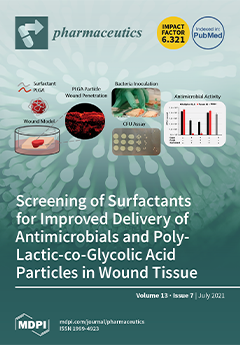In this work, a method for the preparation of the highly lipophilic labeling synthon [
89Zr]Zr(oxinate)
4 was optimized for the radiolabeling of liposomes and human induced pluripotent stem cells (hiPSCs). The aim was to establish a robust and reliable labeling protocol
[...] Read more.
In this work, a method for the preparation of the highly lipophilic labeling synthon [
89Zr]Zr(oxinate)
4 was optimized for the radiolabeling of liposomes and human induced pluripotent stem cells (hiPSCs). The aim was to establish a robust and reliable labeling protocol for enabling up to one week positron emission tomography (PET) tracing of lipid-based nanomedicines and transplanted or injected cells, respectively. [
89Zr]Zr(oxinate)
4 was prepared from oxine (8-hydroxyquinoline) and [
89Zr]Zr(OH)
2(C
2O
4). Earlier introduced liquid–liquid extraction methods were simplified by the optimization of buffering, pH, temperature and reaction times. For quality control, thin-layer chromatography (TLC), size-exclusion chromatography (SEC) and centrifugation were employed. Subsequently, the
89Zr-complex was incorporated into liposome formulations. PET/CT imaging of
89Zr-labeled liposomes was performed in healthy mice. Cell labeling was accomplished in PBS using suspensions of 3 × 10
6 hiPSCs, each. [
89Zr]Zr(oxinate)
4 was synthesized in very high radiochemical yields of 98.7% (96.8% ± 2.8%). Similarly, high internalization rates (≥90%) of [
89Zr]Zr(oxinate)
4 into liposomes were obtained over an 18 h incubation period. MicroPET and biodistribution studies confirmed the labeled nanocarriers’ in vivo stability. Human iPSCs incorporated the labeling agent within 30 min with ~50% efficiency. Prolonged PET imaging is an ideal tool in the development of lipid-based nanocarriers for drug delivery and cell therapies. To this end, a reliable and reproducible
89Zr radiolabeling method was developed and tested successfully in a model liposome system and in hiPSCs alike.
Full article






